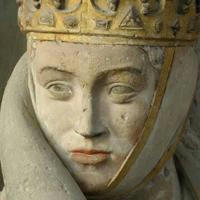
The Exaltation of Beauty
European art and culture. @Revolt888 @WrathOfGnon77 @OrthodoxSpirituality555
Больше6 088
Подписчики
+924 часа
+497 дней
+21230 дней
- Подписчики
- Просмотры постов
- ER - коэффициент вовлеченности
Загрузка данных...
Прирост подписчиков
Загрузка данных...
A mother butters bread while her son stands beside her, his head bent in prayer over the food. He is about to depart for the school seen through the open front door and identified by the sign reading schole. A small triangular niche above the inner doorway holds several books and a candlestick, perhaps alluding to the enlightenment that education brings. A small top lying on the floor in front of the chamber doorway may refer to a Dutch proverb that states a child and a top will both fall idle unless continually "whipped." Education and proper attitudes toward child-rearing were important issues in Protestant countries during the century, and many paintings made during this period contain moral overtones and pious references.
The use of vertical lines and geometric forms conveys the orderly simplicity of this interior scene. Natural light spills through the front door and onto the tiled entryway. In contrast, the foreground interior is dark, emphasizing a solemn and reverent moment in Dutch domestic life.
fd2bd011-7ce6-4935-9e41-6cc8e4880ca5_2343.jpg1.54 MB
Фото недоступноПоказать в Telegram
A Woman Preparing Bread and Butter for a Boy, about 1660–1663, by Pieter de Hooch, 68.6 × 53.3 cm, Getty Museum
Pieter de Hooch worked in the small and relatively quiet city of Delft from 1652 to about 1660. Like other Delft artists, most notably Carel Fabritius and Johannes Vermeer, De Hooch painted everyday scenes that are remarkable for their clarity of perspective and harmony of light. He gave order to his compositions by emphasizing the geometry of architectural elements. The positioning of doors, windows and their shutters, floor tiles, and bricks was all carefully calculated and painted.
Pieter de Hooch, A Dutch Courtyard, 1658.jpg4.36 MB
Фото недоступноПоказать в Telegram
Pieter de Hooch, A Dutch Courtyard, 1658/1660, oil on canvas, 69.5 x 60 cm, NGA
Women going about their daily chores or attending to visitors, such as the soldiers seen here sitting around a table smoking and drinking, are a frequent theme in De Hooch’s work. The man wearing a breastplate is setting down the pitcher he has used to refill the "pass-glass" held by the woman. The pass-glass was used in drinking games. Each participant had to drink down to a circular line on the glass; failing to reach the exact level, the reveler would be required to drink down to the next ring. Only when this was done successfully would the glass be passed on to the next participant. The little girl carries a brazier of hot coals so that the two soldiers can light their long-stemmed, white clay pipes. Despite its apparent realism, and the presence of the tower of the Nieuwe Kerk in the background, the scene probably does not depict a specific courtyard.
The painting’s traditional title of The Bedroom is somewhat misleading, for the box bed against the wall was part of a large multifunctional room. The mother, busy tending to the chamber pot and airing out the linens, prepares the room for its daytime uses. The harmonious character of De Hooch’s painting and its emphasis on the mother’s dual responsibility as nurturer of her child and caretaker of the home, embody the ideal of Dutch domestic felicity.
Pieter de Hooch excelled in the sensitive depiction of people going about their daily lives, be it inside their houses or in the sheltered environment of an urban courtyard. His masterly control of light, color, and complex perspectival construction can be compared to the work of Johannes Vermeer, his contemporary and colleague in Delft.
Pieter de Hooch, The Bedroom, 1658.jpg3.67 MB
Фото недоступноПоказать в Telegram
Pieter de Hooch, The Bedroom, 1658/1660, oil on canvas, 51 x 60 cm, NGA
Through his careful arrangement of the interior space in The Bedroom and his treatment of light, De Hooch infused this everyday scene with an extraordinary intimacy and warmth. Two light sources—the double windows on the left plus the open Dutch door and transom at the front of the house—illuminate the child who opens the door to the inner room. The doorway is flanked by rows of glazed Dutch tiles depicting popular children’s games. Based on the dress, the youngster could be either a girl or a boy. All small children wore skirts, regardless of gender, and the age at which a boy would change to wearing breeches was rather fluid. It is possible that De Hooch depicted his own family: his wife, Jannetje, and either his son, Peter, born in 1655, or his daughter, Anna, born in 1656.
Orazio Gentileschi's brooding image of David contemplating the head of Goliath reflects a new type of meditative image introduced at the beginning of the seventeenth century by Caravaggio. Traditionally David was shown either as an uncompromised biblical hero slaying Goliath or as a triumphant youth displaying the giant's decapitated head. Orazio's David does not interact with Goliath's head, rather he stands beside it lost in a moment of deep introspection, evoking a pensive atmosphere. David's body is pushed towards the picture plane and set off against a background of dense, dark verdant foliage. The subject of David and Goliath was one close to Gentileschi, who painted it several times.
Orazio_Gentileschi_David_Contemplating_the_Head_of_Goliath.jpeg4.53 KB
Фото недоступноПоказать в Telegram
David Contemplating the Head of Goliath, c. 1610, by Orazio Gentileschi, oil on copper, 37 x 29 cm, Gemäldegalerie, Berlin
Фото недоступноПоказать в Telegram
Guillaime Courtois, David and Goliath, between 1650 and 1660, oil on canvas, 69 cm × 153 cm, Capitoline Museums
Выберите другой тариф
Ваш текущий тарифный план позволяет посмотреть аналитику только 5 каналов. Чтобы получить больше, выберите другой план.
